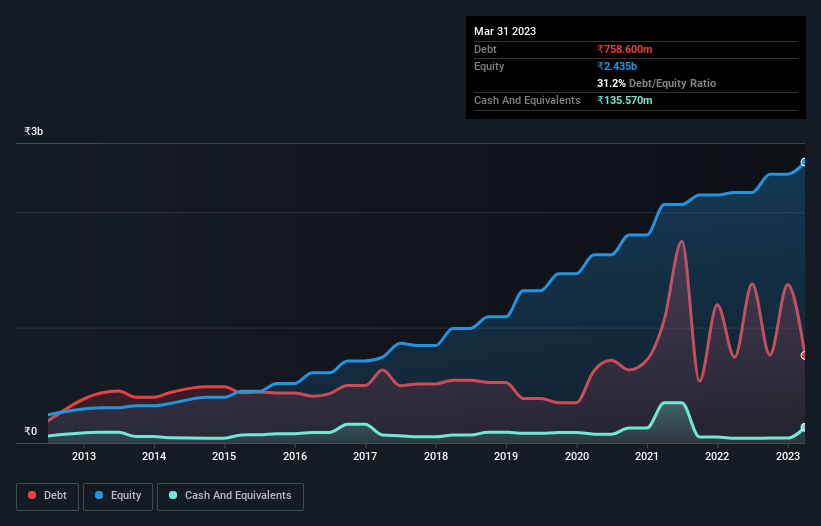Tasty Bite Eatables (NSE:TASTYBITE) Seems To Use Debt Quite Sensibly
Some say volatility, rather than debt, is the best way to think about risk as an investor, but Warren Buffett famously said that 'Volatility is far from synonymous with risk.' So it might be obvious that you need to consider debt, when you think about how risky any given stock is, because too much debt can sink a company. Importantly, Tasty Bite Eatables Limited (NSE:TASTYBITE) does carry debt. But the more important question is: how much risk is that debt creating?
Why Does Debt Bring Risk?
Generally speaking, debt only becomes a real problem when a company can't easily pay it off, either by raising capital or with its own cash flow. Ultimately, if the company can't fulfill its legal obligations to repay debt, shareholders could walk away with nothing. However, a more frequent (but still costly) occurrence is where a company must issue shares at bargain-basement prices, permanently diluting shareholders, just to shore up its balance sheet. Of course, plenty of companies use debt to fund growth, without any negative consequences. The first step when considering a company's debt levels is to consider its cash and debt together.
See our latest analysis for Tasty Bite Eatables
What Is Tasty Bite Eatables's Net Debt?
The chart below, which you can click on for greater detail, shows that Tasty Bite Eatables had ₹758.6m in debt in March 2023; about the same as the year before. However, because it has a cash reserve of ₹135.6m, its net debt is less, at about ₹623.0m.

How Strong Is Tasty Bite Eatables' Balance Sheet?
Zooming in on the latest balance sheet data, we can see that Tasty Bite Eatables had liabilities of ₹1.25b due within 12 months and liabilities of ₹921.9m due beyond that. On the other hand, it had cash of ₹135.6m and ₹648.0m worth of receivables due within a year. So its liabilities outweigh the sum of its cash and (near-term) receivables by ₹1.39b.
Since publicly traded Tasty Bite Eatables shares are worth a total of ₹33.1b, it seems unlikely that this level of liabilities would be a major threat. But there are sufficient liabilities that we would certainly recommend shareholders continue to monitor the balance sheet, going forward.
We measure a company's debt load relative to its earnings power by looking at its net debt divided by its earnings before interest, tax, depreciation, and amortization (EBITDA) and by calculating how easily its earnings before interest and tax (EBIT) cover its interest expense (interest cover). This way, we consider both the absolute quantum of the debt, as well as the interest rates paid on it.
Looking at its net debt to EBITDA of 0.80 and interest cover of 5.3 times, it seems to us that Tasty Bite Eatables is probably using debt in a pretty reasonable way. So we'd recommend keeping a close eye on the impact financing costs are having on the business. Notably, Tasty Bite Eatables's EBIT launched higher than Elon Musk, gaining a whopping 161% on last year. There's no doubt that we learn most about debt from the balance sheet. But it is Tasty Bite Eatables's earnings that will influence how the balance sheet holds up in the future. So when considering debt, it's definitely worth looking at the earnings trend. Click here for an interactive snapshot.
Finally, a business needs free cash flow to pay off debt; accounting profits just don't cut it. So the logical step is to look at the proportion of that EBIT that is matched by actual free cash flow. In the last three years, Tasty Bite Eatables's free cash flow amounted to 22% of its EBIT, less than we'd expect. That's not great, when it comes to paying down debt.
Our View
Happily, Tasty Bite Eatables's impressive EBIT growth rate implies it has the upper hand on its debt. But, on a more sombre note, we are a little concerned by its conversion of EBIT to free cash flow. When we consider the range of factors above, it looks like Tasty Bite Eatables is pretty sensible with its use of debt. That means they are taking on a bit more risk, in the hope of boosting shareholder returns. The balance sheet is clearly the area to focus on when you are analysing debt. But ultimately, every company can contain risks that exist outside of the balance sheet. We've identified 1 warning sign with Tasty Bite Eatables , and understanding them should be part of your investment process.
Of course, if you're the type of investor who prefers buying stocks without the burden of debt, then don't hesitate to discover our exclusive list of net cash growth stocks, today.
Valuation is complex, but we're here to simplify it.
Discover if Tasty Bite Eatables might be undervalued or overvalued with our detailed analysis, featuring fair value estimates, potential risks, dividends, insider trades, and its financial condition.
Access Free AnalysisHave feedback on this article? Concerned about the content? Get in touch with us directly. Alternatively, email editorial-team (at) simplywallst.com.
This article by Simply Wall St is general in nature. We provide commentary based on historical data and analyst forecasts only using an unbiased methodology and our articles are not intended to be financial advice. It does not constitute a recommendation to buy or sell any stock, and does not take account of your objectives, or your financial situation. We aim to bring you long-term focused analysis driven by fundamental data. Note that our analysis may not factor in the latest price-sensitive company announcements or qualitative material. Simply Wall St has no position in any stocks mentioned.
About NSEI:TASTYBITE
Tasty Bite Eatables
Manufactures and sells prepared foods in India and internationally.
Flawless balance sheet with proven track record.
Similar Companies
Market Insights
Community Narratives



